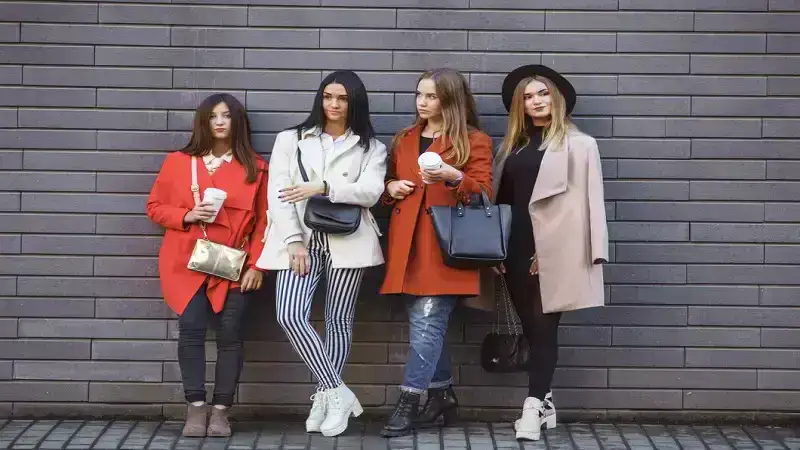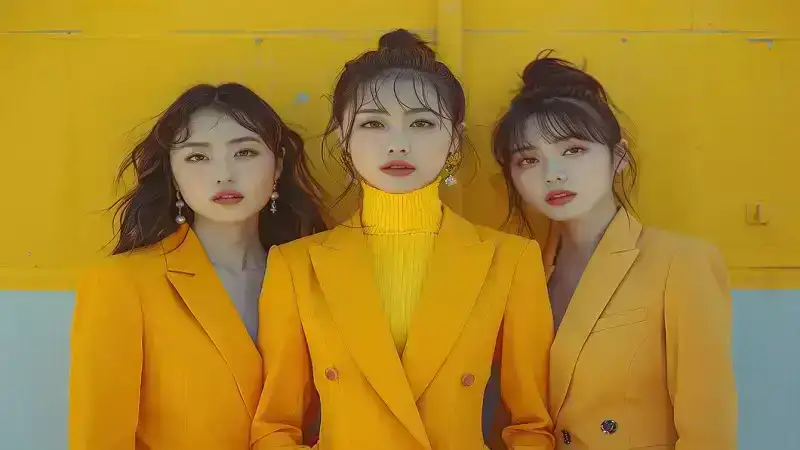Fashion is an ever-evolving form of self-expression. It reflects personal tastes, cultural backgrounds, and individual values, shaping how we perceive ourselves and others. The way you dress communicates something about who you are, and today, there are countless fashion aesthetics that allow individuals to express themselves in unique ways. In this article, we explore 6 types of fashion aesthetics, each representing distinct styles, influences, and personality traits. Let’s delve into the details and understand how each aesthetic plays a role in the world of fashion.
Minimalist Aesthetic
The first style in our exploration of the 6 types of fashion aesthetics is the Minimalist Aesthetic. Minimalism focuses on simplicity, clean lines, and understated elegance. It is about stripping away excess and focusing on what is essential. This aesthetic is perfect for those who prefer a timeless, organized wardrobe that is versatile and refined.
Minimalist fashion often features neutral color palettes, such as white, black, beige, gray, and muted tones. The emphasis is on classic pieces that can be worn year-round without appearing outdated. Common minimalist wardrobe staples include well-fitted blazers, tailored trousers, simple crewneck sweaters, and clean, structured handbags.
Quality over quantity is a key principle of minimalist fashion. Those who embrace this aesthetic invest in high-quality garments that last for years rather than following seasonal trends. The fabrics used in minimalist fashion are typically natural and durable, such as cotton, wool, and leather. These fabrics provide both comfort and longevity, reinforcing the minimalist approach to sustainability and mindful consumption.
The minimalist aesthetic goes beyond just clothing. It reflects a broader lifestyle that values simplicity, functionality, and intentionality. For those who value a clutter-free, organized life, minimalism is not just a fashion choice but a way of living.
Bohemian (Boho) Aesthetic
Next on the list of 6 types of fashion aesthetics is the Bohemian Aesthetic, commonly known as “Boho.” This aesthetic is defined by its carefree, eclectic, and artistic style, deeply rooted in the countercultures of the 1960s and 1970s. The boho aesthetic is perfect for those who embrace creativity, freedom, and individuality in their fashion choices.
Bohemian fashion is characterized by flowy, relaxed silhouettes and a mix of bold patterns and textures. Key elements of the boho wardrobe include long, flowing maxi dresses, wide-brimmed hats, fringe details, and layered jewelry. The style often incorporates earthy tones like browns, oranges, and greens, combined with colorful, intricate patterns such as florals, paisleys, and geometric designs.
Accessories play a significant role in the bohemian aesthetic. Chunky, layered necklaces, oversized rings, and bracelets made from natural materials like wood, leather, and stones are common. Handcrafted and artisanal items, such as woven bags or embroidered shawls, are also popular choices for completing the boho look.
Bohemian fashion is not just about clothes—it’s a lifestyle. Those who identify with the boho aesthetic often live in harmony with nature and prioritize sustainability, preferring to shop at thrift stores or buy handmade items. The boho aesthetic represents a free-spirited, non-conformist attitude that values self-expression over following mainstream trends.
Streetwear Aesthetic
Among the 6 types of fashion aesthetics, the Streetwear Aesthetic has arguably had the most influence on contemporary fashion. Originally rooted in urban subcultures, streetwear has evolved into a global phenomenon that blends elements of casual wear, sportswear, and high fashion. It reflects the intersection of comfort and style, creating a look that is effortlessly cool and edgy.
The streetwear aesthetic is characterized by oversized, relaxed silhouettes and bold, graphic designs. Key pieces in a streetwear wardrobe include hoodies, t-shirts, joggers, and sneakers. Streetwear brands like Supreme, Off-White, and Adidas have played a pivotal role in shaping this aesthetic, often collaborating with high-fashion designers to blur the lines between casual and luxury fashion.
Logos and branding are essential to streetwear. Many streetwear enthusiasts wear items with large, visible logos or graphic prints, which can convey a sense of exclusivity and status. The culture of limited-edition drops and collaborations has made streetwear not only a fashion statement but also a collectible market.
The origins of streetwear are deeply tied to hip-hop culture, skateboarding, and basketball, but it has since transcended these roots. Streetwear is now embraced by people from all walks of life who appreciate its laid-back yet rebellious attitude. The aesthetic allows for individuality, where comfort meets statement pieces, and personal style becomes a form of self-expression.

Vintage Aesthetic
The Vintage Aesthetic is all about nostalgia and celebrating styles from the past. It pays homage to bygone eras, from the elegance of the 1920s to the bold, funky fashion of the 1980s. People who love vintage fashion often seek out clothing from specific decades, infusing their modern wardrobe with a touch of history and charm.
fashion is characterized by iconic pieces that defined the style of a particular era. For example, the flapper dresses of the 1920s, with their beaded details and drop waists, evoke the glamour of the Jazz Age. The pin-up style of the 1950s, with its high-waisted skirts and polka dot patterns, reflects post-war optimism. The 1970s brought bell-bottom jeans, suede jackets, and flowing kaftans, while the 1980s favored power suits, bold colors, and oversized accessories.
Shopping for vintage clothing often involves visiting thrift stores, flea markets, or online resale platforms. Not only does this aesthetic promote sustainability by repurposing old clothes, but it also allows for a truly unique wardrobe. Vintage enthusiasts often mix and match pieces from different decades, creating outfits that are one-of-a-kind.
The vintage aesthetic is not only about the clothes but also about embracing the values and craftsmanship of the past. Those who love vintage fashion appreciate the history behind each piece and often take pride in preserving and restoring older garments. The timeless appeal of vintage fashion ensures that styles from the past will continue to inspire future generations.
Preppy Aesthetic
The Preppy Aesthetic is one of the more polished and traditional looks among the 6 types of fashion aesthetics. Originating from Ivy League universities in the United States, this aesthetic is characterized by clean lines, structured clothing, and a sense of sophistication. Preppy fashion reflects a lifestyle of privilege, affluence, and refinement, often associated with upper-class or elite social groups.
Preppy style is all about looking neat, orderly, and put-together. Wardrobe staples include polo shirts, blazers, pleated skirts, and cable-knit sweaters. Patterns such as plaid, stripes, and argyle are common in preppy fashion, often paired with bright colors like navy blue, hunter green, and sunny yellow. Footwear typically includes loafers, boat shoes, or ballet flats, contributing to the polished look.
Accessories are an essential part of the preppy aesthetic. Pearls, headbands, and silk scarves add a touch of elegance, while structured bags and leather belts complete the ensemble. Preppy fashion is often inspired by traditional sports such as tennis, golf, and rowing, which is why items like tennis skirts and varsity sweaters are iconic pieces within this aesthetic.
Preppy fashion represents a blend of tradition and modernity. It is timeless and elegant, appealing to those who appreciate classic styles that never go out of fashion. Those who embrace the preppy aesthetic often prioritize quality and craftsmanship, choosing well-made pieces that last. The preppy look exudes confidence, sophistication, and a sense of belonging to a more formal, upper-class world.
Grunge Aesthetic
The final entry in our list of 6 types of fashion aesthetics is the Grunge Aesthetic. Born in the 1990s out of the alternative rock scene, grunge fashion is all about rebellion, non-conformity, and rejecting mainstream trends. This aesthetic is characterized by its edgy, “undone” look that often mixes elements of punk, rock, and casual wear.
Grunge fashion is defined by its oversized, layered, and often distressed clothing. Key pieces include flannel shirts, ripped jeans, band t-shirts, and combat boots. The color palette is typically dark, with shades of black, gray, maroon, and olive green being dominant. Unlike other aesthetics that prioritize looking polished, grunge fashion embraces a more worn, lived-in appearance.
Thrift stores play a big role in the grunge aesthetic, as many people who identify with this style prefer to wear second-hand clothing. The aesthetic often includes DIY elements, such as patches, pins, or customized clothing. Grunge fashion is about individuality and not caring about societal norms, which is why it resonates with those who reject the polished, commercialized fashion world.
Grunge is more than just a fashion statement; it’s a lifestyle that reflects a laid-back, anti-establishment attitude. Those who embrace the grunge aesthetic often value comfort over style, but in doing so, they create a look that is effortlessly cool and authentic.
Conclusion: Embracing Your Fashion Aesthetic
The 6 types of fashion aesthetics—minimalist, bohemian, streetwear, vintage, preppy, and grunge—highlight the diversity and creativity in the world of fashion. Each aesthetic offers a unique way for individuals to express themselves, whether they prefer the simplicity of minimalism, the artistic freedom of boho, or the rebellious spirit of grunge. Fashion is an ever-changing canvas, and your personal aesthetic can evolve as you do.
No matter which of the 6 types of fashion aesthetics you resonate with, the key is to embrace your individuality and use fashion as a tool for self-expression. Your style is a reflection of who Absolutely! Let dive deeper into each aesthetic and explore more about how these styles can impact personal identity, societal trends, and cultural influences.
